University Name: Sociology 2 - Urban Planning Report and Analysis
VerifiedAdded on 2022/11/15
|6
|1340
|327
Report
AI Summary
This report delves into the complexities of urban planning, examining the seminal works of Rittel and Webber on 'wicked problems' and Arnstein's 'Ladder of Citizen Participation.' Rittel and Webber's analysis highlights the challenges in social policy and planning, particularly the difficulties in solving problems that are not easily defined or solved by traditional methods. The report discusses the ten characteristics of 'wicked problems,' which are complex issues with no definitive solutions. Arnstein's 'Ladder of Citizen Participation' is then explored, which outlines different levels of citizen involvement in planning processes. The report analyzes the eight rungs of the ladder, from manipulation to citizen control, and assesses the extent of power redistribution in each level. The report provides a comprehensive overview of these concepts, offering insights into the intricacies of urban planning and citizen engagement.
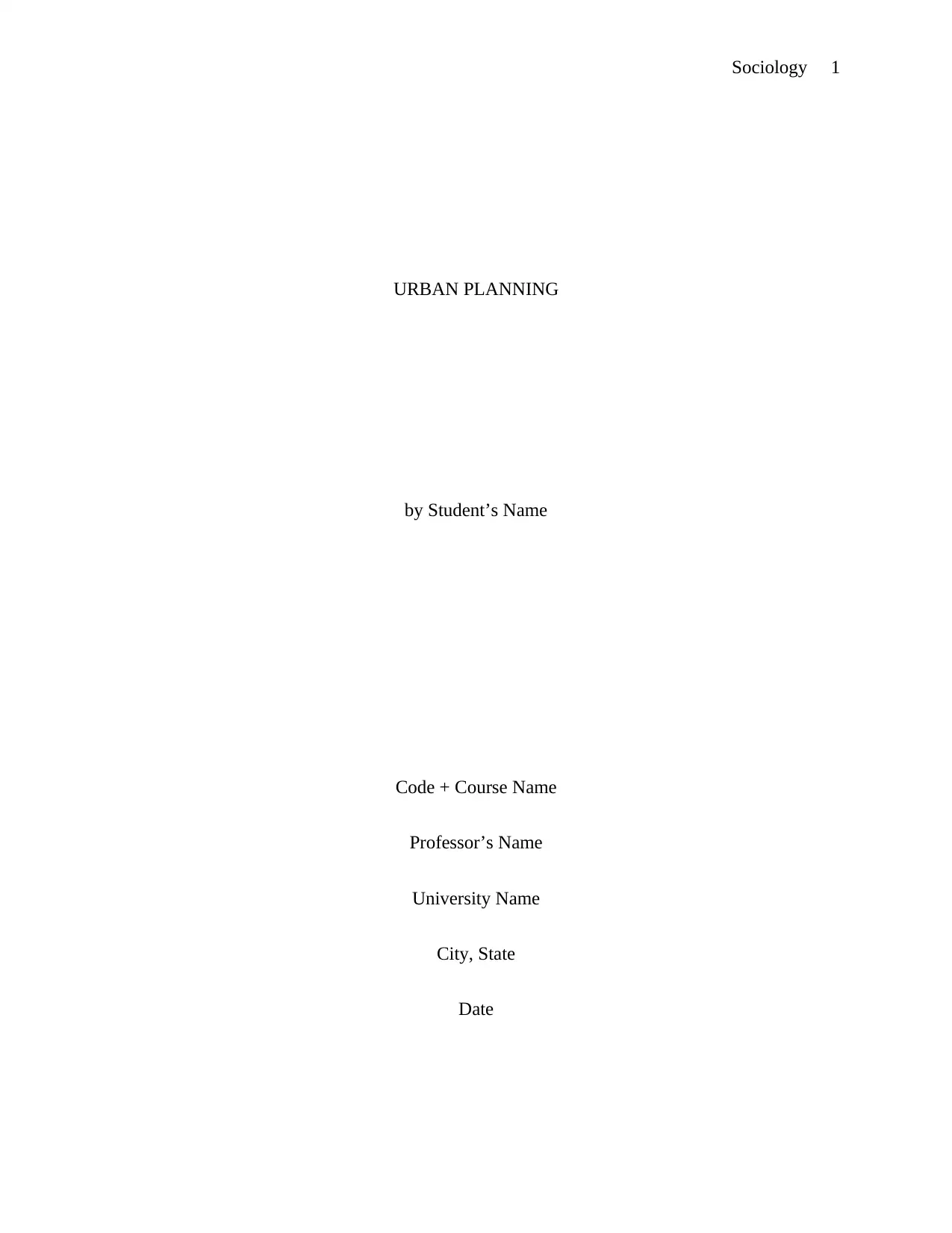
Sociology 1
URBAN PLANNING
by Student’s Name
Code + Course Name
Professor’s Name
University Name
City, State
Date
URBAN PLANNING
by Student’s Name
Code + Course Name
Professor’s Name
University Name
City, State
Date
Paraphrase This Document
Need a fresh take? Get an instant paraphrase of this document with our AI Paraphraser
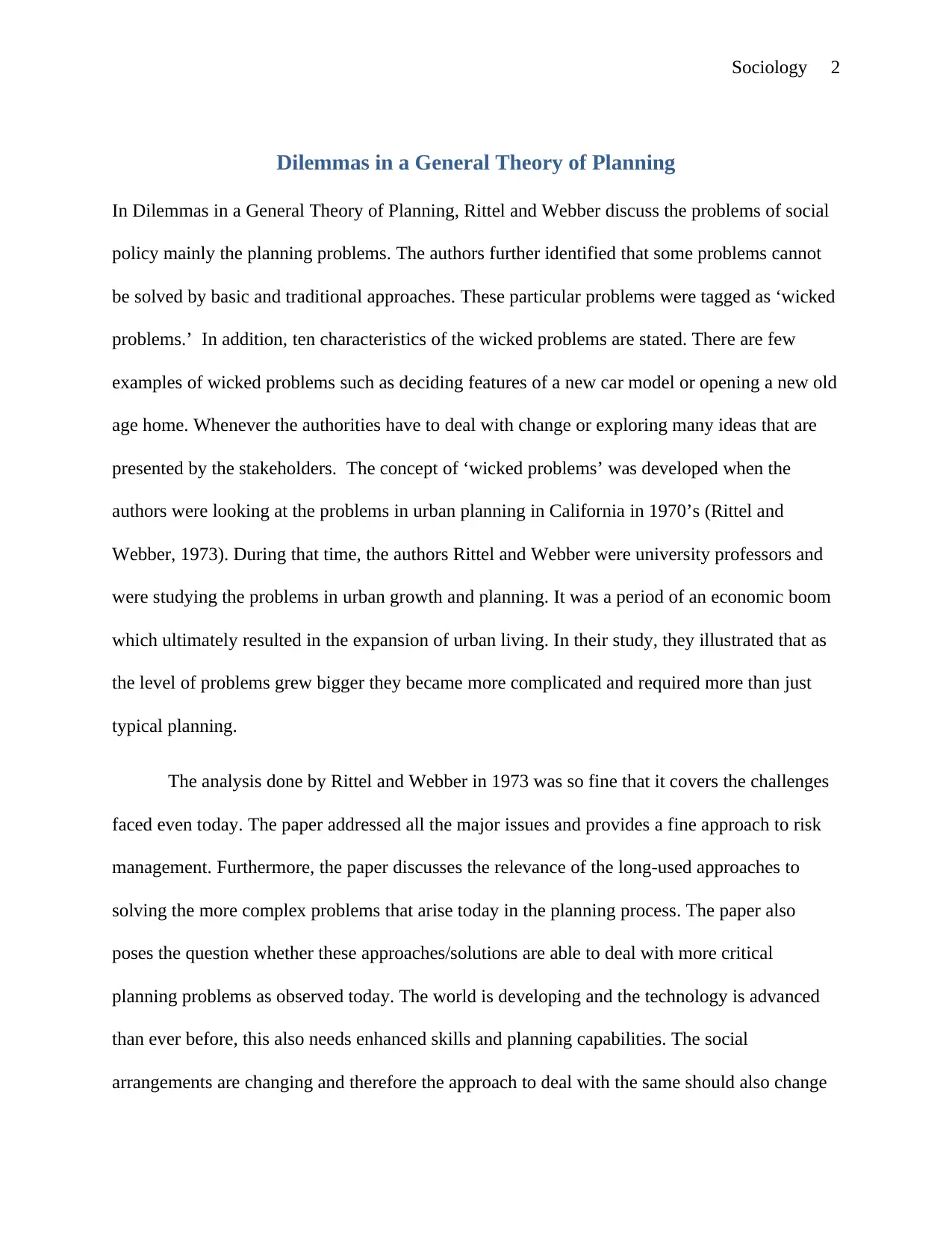
Sociology 2
Dilemmas in a General Theory of Planning
In Dilemmas in a General Theory of Planning, Rittel and Webber discuss the problems of social
policy mainly the planning problems. The authors further identified that some problems cannot
be solved by basic and traditional approaches. These particular problems were tagged as ‘wicked
problems.’ In addition, ten characteristics of the wicked problems are stated. There are few
examples of wicked problems such as deciding features of a new car model or opening a new old
age home. Whenever the authorities have to deal with change or exploring many ideas that are
presented by the stakeholders. The concept of ‘wicked problems’ was developed when the
authors were looking at the problems in urban planning in California in 1970’s (Rittel and
Webber, 1973). During that time, the authors Rittel and Webber were university professors and
were studying the problems in urban growth and planning. It was a period of an economic boom
which ultimately resulted in the expansion of urban living. In their study, they illustrated that as
the level of problems grew bigger they became more complicated and required more than just
typical planning.
The analysis done by Rittel and Webber in 1973 was so fine that it covers the challenges
faced even today. The paper addressed all the major issues and provides a fine approach to risk
management. Furthermore, the paper discusses the relevance of the long-used approaches to
solving the more complex problems that arise today in the planning process. The paper also
poses the question whether these approaches/solutions are able to deal with more critical
planning problems as observed today. The world is developing and the technology is advanced
than ever before, this also needs enhanced skills and planning capabilities. The social
arrangements are changing and therefore the approach to deal with the same should also change
Dilemmas in a General Theory of Planning
In Dilemmas in a General Theory of Planning, Rittel and Webber discuss the problems of social
policy mainly the planning problems. The authors further identified that some problems cannot
be solved by basic and traditional approaches. These particular problems were tagged as ‘wicked
problems.’ In addition, ten characteristics of the wicked problems are stated. There are few
examples of wicked problems such as deciding features of a new car model or opening a new old
age home. Whenever the authorities have to deal with change or exploring many ideas that are
presented by the stakeholders. The concept of ‘wicked problems’ was developed when the
authors were looking at the problems in urban planning in California in 1970’s (Rittel and
Webber, 1973). During that time, the authors Rittel and Webber were university professors and
were studying the problems in urban growth and planning. It was a period of an economic boom
which ultimately resulted in the expansion of urban living. In their study, they illustrated that as
the level of problems grew bigger they became more complicated and required more than just
typical planning.
The analysis done by Rittel and Webber in 1973 was so fine that it covers the challenges
faced even today. The paper addressed all the major issues and provides a fine approach to risk
management. Furthermore, the paper discusses the relevance of the long-used approaches to
solving the more complex problems that arise today in the planning process. The paper also
poses the question whether these approaches/solutions are able to deal with more critical
planning problems as observed today. The world is developing and the technology is advanced
than ever before, this also needs enhanced skills and planning capabilities. The social
arrangements are changing and therefore the approach to deal with the same should also change
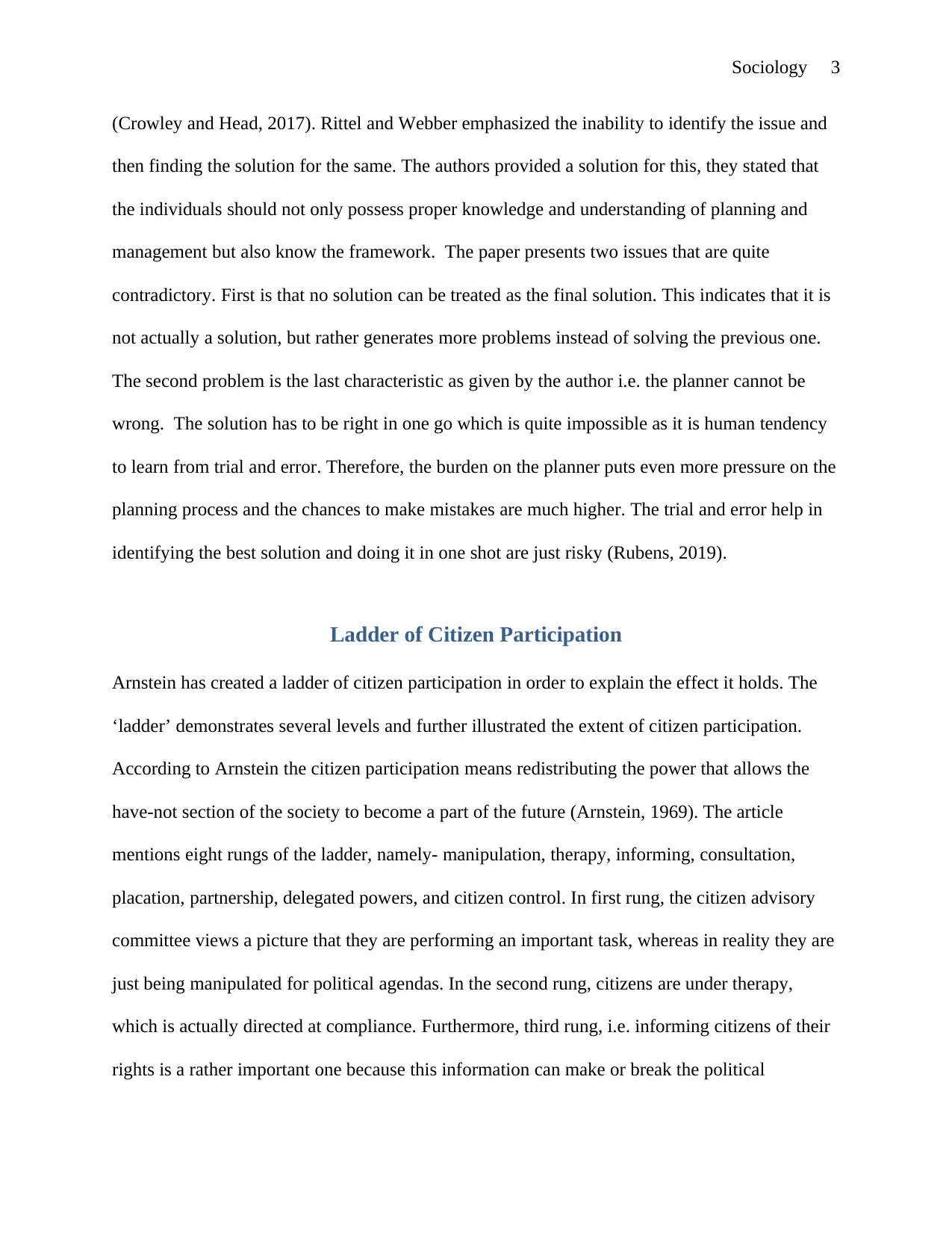
Sociology 3
(Crowley and Head, 2017). Rittel and Webber emphasized the inability to identify the issue and
then finding the solution for the same. The authors provided a solution for this, they stated that
the individuals should not only possess proper knowledge and understanding of planning and
management but also know the framework. The paper presents two issues that are quite
contradictory. First is that no solution can be treated as the final solution. This indicates that it is
not actually a solution, but rather generates more problems instead of solving the previous one.
The second problem is the last characteristic as given by the author i.e. the planner cannot be
wrong. The solution has to be right in one go which is quite impossible as it is human tendency
to learn from trial and error. Therefore, the burden on the planner puts even more pressure on the
planning process and the chances to make mistakes are much higher. The trial and error help in
identifying the best solution and doing it in one shot are just risky (Rubens, 2019).
Ladder of Citizen Participation
Arnstein has created a ladder of citizen participation in order to explain the effect it holds. The
‘ladder’ demonstrates several levels and further illustrated the extent of citizen participation.
According to Arnstein the citizen participation means redistributing the power that allows the
have-not section of the society to become a part of the future (Arnstein, 1969). The article
mentions eight rungs of the ladder, namely- manipulation, therapy, informing, consultation,
placation, partnership, delegated powers, and citizen control. In first rung, the citizen advisory
committee views a picture that they are performing an important task, whereas in reality they are
just being manipulated for political agendas. In the second rung, citizens are under therapy,
which is actually directed at compliance. Furthermore, third rung, i.e. informing citizens of their
rights is a rather important one because this information can make or break the political
(Crowley and Head, 2017). Rittel and Webber emphasized the inability to identify the issue and
then finding the solution for the same. The authors provided a solution for this, they stated that
the individuals should not only possess proper knowledge and understanding of planning and
management but also know the framework. The paper presents two issues that are quite
contradictory. First is that no solution can be treated as the final solution. This indicates that it is
not actually a solution, but rather generates more problems instead of solving the previous one.
The second problem is the last characteristic as given by the author i.e. the planner cannot be
wrong. The solution has to be right in one go which is quite impossible as it is human tendency
to learn from trial and error. Therefore, the burden on the planner puts even more pressure on the
planning process and the chances to make mistakes are much higher. The trial and error help in
identifying the best solution and doing it in one shot are just risky (Rubens, 2019).
Ladder of Citizen Participation
Arnstein has created a ladder of citizen participation in order to explain the effect it holds. The
‘ladder’ demonstrates several levels and further illustrated the extent of citizen participation.
According to Arnstein the citizen participation means redistributing the power that allows the
have-not section of the society to become a part of the future (Arnstein, 1969). The article
mentions eight rungs of the ladder, namely- manipulation, therapy, informing, consultation,
placation, partnership, delegated powers, and citizen control. In first rung, the citizen advisory
committee views a picture that they are performing an important task, whereas in reality they are
just being manipulated for political agendas. In the second rung, citizens are under therapy,
which is actually directed at compliance. Furthermore, third rung, i.e. informing citizens of their
rights is a rather important one because this information can make or break the political
⊘ This is a preview!⊘
Do you want full access?
Subscribe today to unlock all pages.

Trusted by 1+ million students worldwide
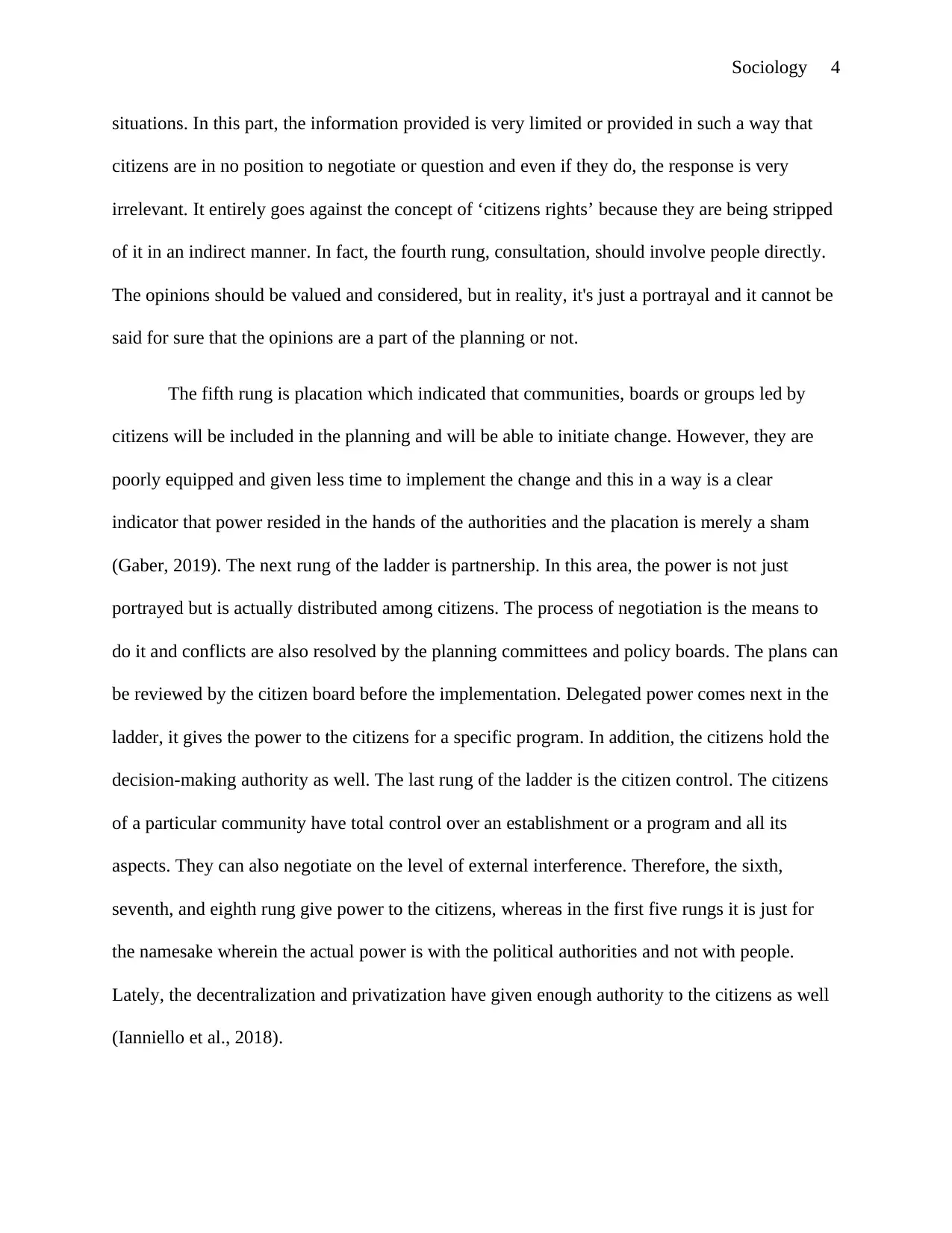
Sociology 4
situations. In this part, the information provided is very limited or provided in such a way that
citizens are in no position to negotiate or question and even if they do, the response is very
irrelevant. It entirely goes against the concept of ‘citizens rights’ because they are being stripped
of it in an indirect manner. In fact, the fourth rung, consultation, should involve people directly.
The opinions should be valued and considered, but in reality, it's just a portrayal and it cannot be
said for sure that the opinions are a part of the planning or not.
The fifth rung is placation which indicated that communities, boards or groups led by
citizens will be included in the planning and will be able to initiate change. However, they are
poorly equipped and given less time to implement the change and this in a way is a clear
indicator that power resided in the hands of the authorities and the placation is merely a sham
(Gaber, 2019). The next rung of the ladder is partnership. In this area, the power is not just
portrayed but is actually distributed among citizens. The process of negotiation is the means to
do it and conflicts are also resolved by the planning committees and policy boards. The plans can
be reviewed by the citizen board before the implementation. Delegated power comes next in the
ladder, it gives the power to the citizens for a specific program. In addition, the citizens hold the
decision-making authority as well. The last rung of the ladder is the citizen control. The citizens
of a particular community have total control over an establishment or a program and all its
aspects. They can also negotiate on the level of external interference. Therefore, the sixth,
seventh, and eighth rung give power to the citizens, whereas in the first five rungs it is just for
the namesake wherein the actual power is with the political authorities and not with people.
Lately, the decentralization and privatization have given enough authority to the citizens as well
(Ianniello et al., 2018).
situations. In this part, the information provided is very limited or provided in such a way that
citizens are in no position to negotiate or question and even if they do, the response is very
irrelevant. It entirely goes against the concept of ‘citizens rights’ because they are being stripped
of it in an indirect manner. In fact, the fourth rung, consultation, should involve people directly.
The opinions should be valued and considered, but in reality, it's just a portrayal and it cannot be
said for sure that the opinions are a part of the planning or not.
The fifth rung is placation which indicated that communities, boards or groups led by
citizens will be included in the planning and will be able to initiate change. However, they are
poorly equipped and given less time to implement the change and this in a way is a clear
indicator that power resided in the hands of the authorities and the placation is merely a sham
(Gaber, 2019). The next rung of the ladder is partnership. In this area, the power is not just
portrayed but is actually distributed among citizens. The process of negotiation is the means to
do it and conflicts are also resolved by the planning committees and policy boards. The plans can
be reviewed by the citizen board before the implementation. Delegated power comes next in the
ladder, it gives the power to the citizens for a specific program. In addition, the citizens hold the
decision-making authority as well. The last rung of the ladder is the citizen control. The citizens
of a particular community have total control over an establishment or a program and all its
aspects. They can also negotiate on the level of external interference. Therefore, the sixth,
seventh, and eighth rung give power to the citizens, whereas in the first five rungs it is just for
the namesake wherein the actual power is with the political authorities and not with people.
Lately, the decentralization and privatization have given enough authority to the citizens as well
(Ianniello et al., 2018).
Paraphrase This Document
Need a fresh take? Get an instant paraphrase of this document with our AI Paraphraser
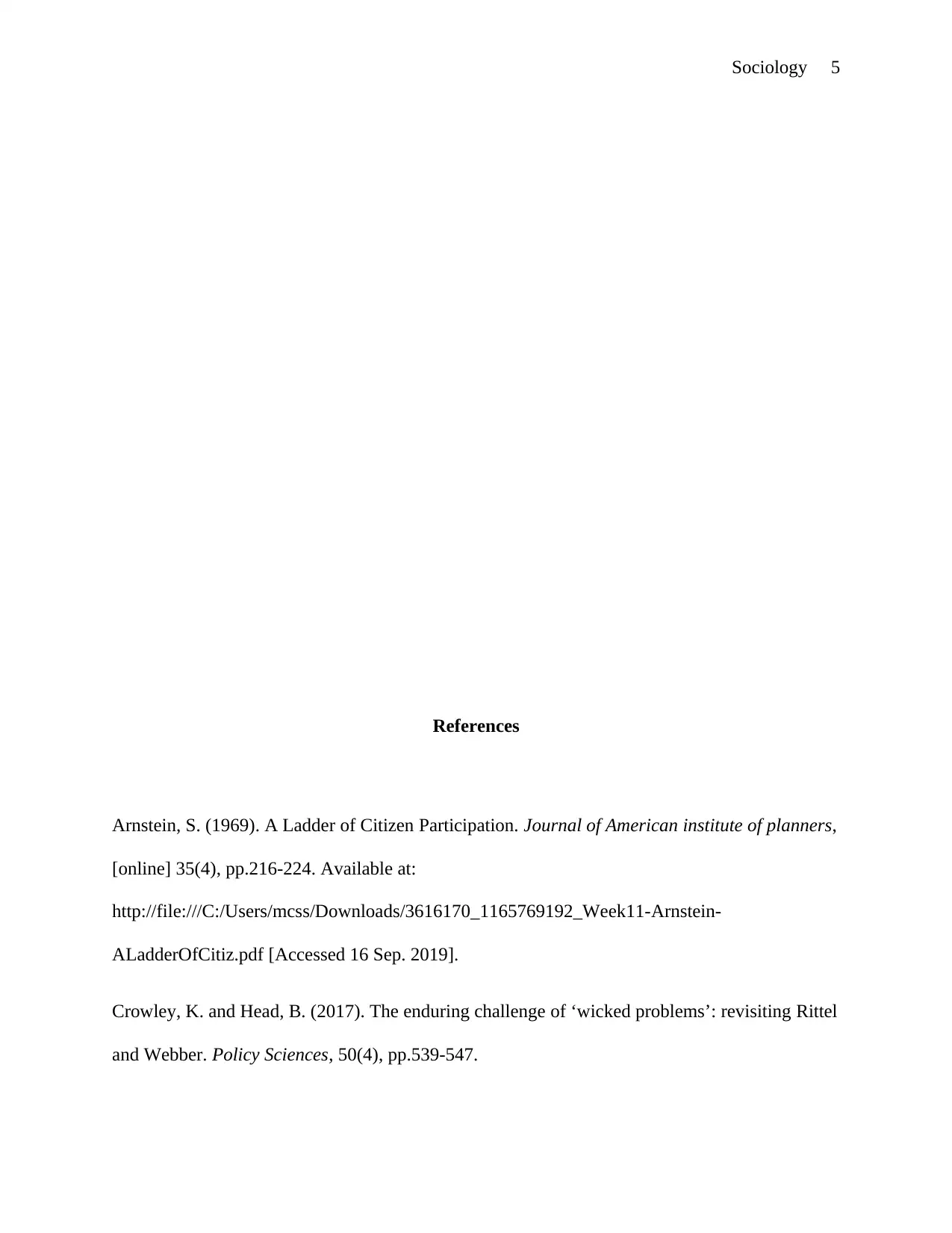
Sociology 5
References
Arnstein, S. (1969). A Ladder of Citizen Participation. Journal of American institute of planners,
[online] 35(4), pp.216-224. Available at:
http://file:///C:/Users/mcss/Downloads/3616170_1165769192_Week11-Arnstein-
ALadderOfCitiz.pdf [Accessed 16 Sep. 2019].
Crowley, K. and Head, B. (2017). The enduring challenge of ‘wicked problems’: revisiting Rittel
and Webber. Policy Sciences, 50(4), pp.539-547.
References
Arnstein, S. (1969). A Ladder of Citizen Participation. Journal of American institute of planners,
[online] 35(4), pp.216-224. Available at:
http://file:///C:/Users/mcss/Downloads/3616170_1165769192_Week11-Arnstein-
ALadderOfCitiz.pdf [Accessed 16 Sep. 2019].
Crowley, K. and Head, B. (2017). The enduring challenge of ‘wicked problems’: revisiting Rittel
and Webber. Policy Sciences, 50(4), pp.539-547.
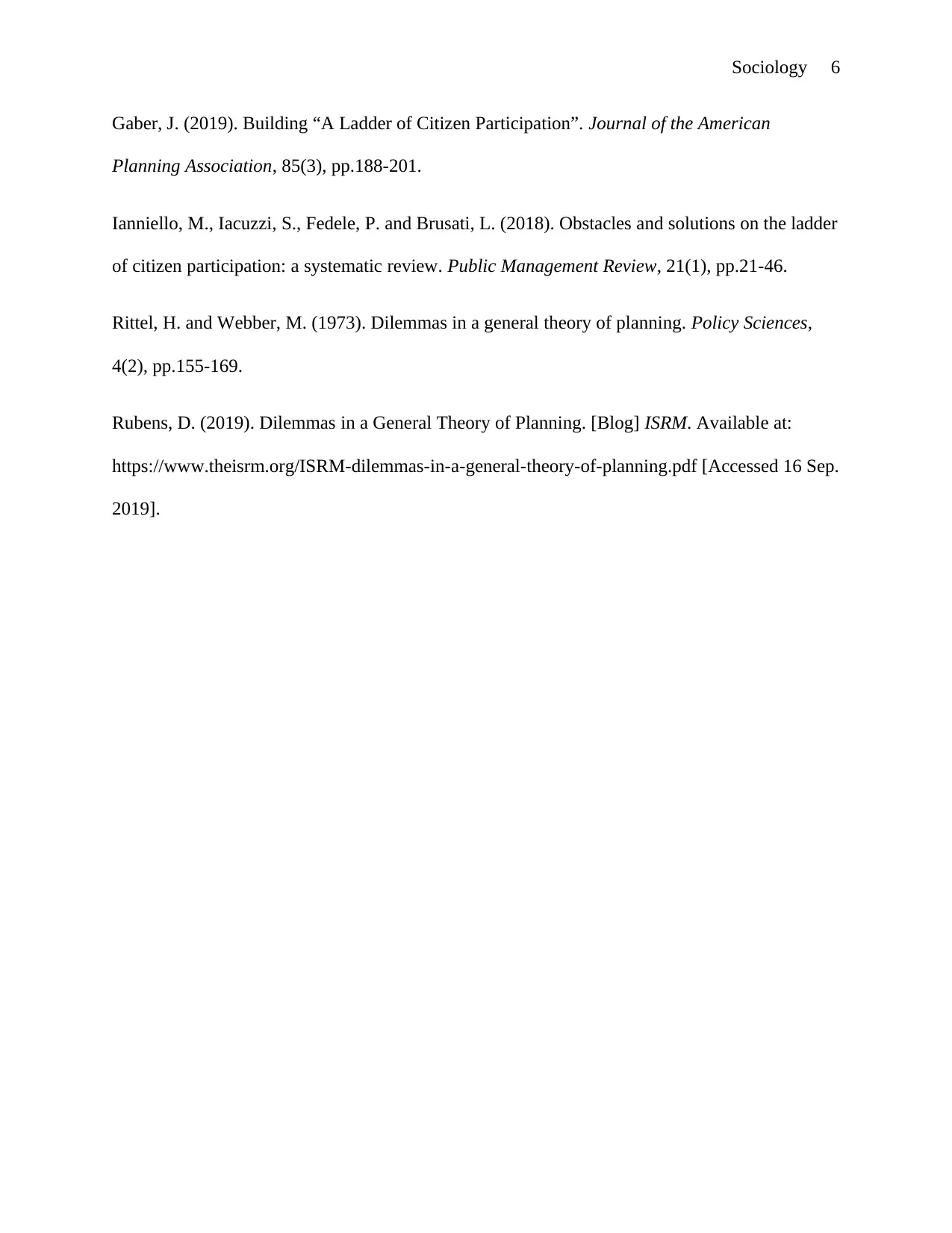
Sociology 6
Gaber, J. (2019). Building “A Ladder of Citizen Participation”. Journal of the American
Planning Association, 85(3), pp.188-201.
Ianniello, M., Iacuzzi, S., Fedele, P. and Brusati, L. (2018). Obstacles and solutions on the ladder
of citizen participation: a systematic review. Public Management Review, 21(1), pp.21-46.
Rittel, H. and Webber, M. (1973). Dilemmas in a general theory of planning. Policy Sciences,
4(2), pp.155-169.
Rubens, D. (2019). Dilemmas in a General Theory of Planning. [Blog] ISRM. Available at:
https://www.theisrm.org/ISRM-dilemmas-in-a-general-theory-of-planning.pdf [Accessed 16 Sep.
2019].
Gaber, J. (2019). Building “A Ladder of Citizen Participation”. Journal of the American
Planning Association, 85(3), pp.188-201.
Ianniello, M., Iacuzzi, S., Fedele, P. and Brusati, L. (2018). Obstacles and solutions on the ladder
of citizen participation: a systematic review. Public Management Review, 21(1), pp.21-46.
Rittel, H. and Webber, M. (1973). Dilemmas in a general theory of planning. Policy Sciences,
4(2), pp.155-169.
Rubens, D. (2019). Dilemmas in a General Theory of Planning. [Blog] ISRM. Available at:
https://www.theisrm.org/ISRM-dilemmas-in-a-general-theory-of-planning.pdf [Accessed 16 Sep.
2019].
⊘ This is a preview!⊘
Do you want full access?
Subscribe today to unlock all pages.

Trusted by 1+ million students worldwide
1 out of 6
Your All-in-One AI-Powered Toolkit for Academic Success.
+13062052269
info@desklib.com
Available 24*7 on WhatsApp / Email
![[object Object]](/_next/static/media/star-bottom.7253800d.svg)
Unlock your academic potential
Copyright © 2020–2025 A2Z Services. All Rights Reserved. Developed and managed by ZUCOL.

